Montana
 My nephew, Josh Griffith is a hard working man, who loves his family, and would do anything for them. He is constantly doing things to improve their home,and he is always able to fix the things that break. Their house is all electric, but they are planning to change it to a gas furnace this year. For now, the family needs 4 trailer loads of wood a year to heat the home without using the electric heat. Josh spend a lot of his free time chopping and splitting the wood so that the family can stay warm all winter. My niece and his wife, Susan helps too, but chopping wood is a tough job for most women, and so Josh does most of it by himself. Josh also spends a good deal of his time keeping the family from being snowed in. He plows snow almost constantly…and does it all without complaint…because he is the provider, and it’s for his family.
My nephew, Josh Griffith is a hard working man, who loves his family, and would do anything for them. He is constantly doing things to improve their home,and he is always able to fix the things that break. Their house is all electric, but they are planning to change it to a gas furnace this year. For now, the family needs 4 trailer loads of wood a year to heat the home without using the electric heat. Josh spend a lot of his free time chopping and splitting the wood so that the family can stay warm all winter. My niece and his wife, Susan helps too, but chopping wood is a tough job for most women, and so Josh does most of it by himself. Josh also spends a good deal of his time keeping the family from being snowed in. He plows snow almost constantly…and does it all without complaint…because he is the provider, and it’s for his family.
Josh has spent a lot of time teaching his girls to ride horses. Susan didn’t grow up around horses, and so she  wasn’t too sure about riding horses.Josh worked with her, and before long, Susan has a good time with it. Their daughters, Jala and Kaytlyn have grown up around horses, and so they will be naturals at it. Josh and Jala go riding quite a bit and have even hunted together. Susan says that Josh is definitely the more hands on parent. I suppose that is because Susan has always had such a soft heart. She parents in a different way. Nevertheless, Josh taught Jala to drive more than Susan did because she said, “I was so scared.” It can be scary to teach a child to drive. It seems that usually one of the other parent has the right temperament for it, and the other doesn’t. Clearly, Josh will be the driving instructor for their girls.
wasn’t too sure about riding horses.Josh worked with her, and before long, Susan has a good time with it. Their daughters, Jala and Kaytlyn have grown up around horses, and so they will be naturals at it. Josh and Jala go riding quite a bit and have even hunted together. Susan says that Josh is definitely the more hands on parent. I suppose that is because Susan has always had such a soft heart. She parents in a different way. Nevertheless, Josh taught Jala to drive more than Susan did because she said, “I was so scared.” It can be scary to teach a child to drive. It seems that usually one of the other parent has the right temperament for it, and the other doesn’t. Clearly, Josh will be the driving instructor for their girls.
Josh does work very hard, but work is not the only thing we do for our families. There is the all important 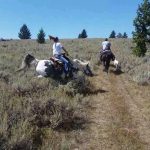 quality time as a family too. This year, Josh and Susan took the girls to the Billings Fair, in Billings Montana. Living in a small town like Powell, the girls don’t usually have a chance to ride on some of the cool rides that they have in bigger cities. This year, the big deal was the Black Out. It is a totally crazy ride, that I would personally never ride. Susan said that all the rides at the Billings fair were so nice, and just seemed safer. Susan doesn’t have to worry about the girls being on the rides, because Josh always rides rides with the girls. Susan stands by holding everyone’s things…sounds like the place I would want to be too. Thankfully for Susan, Josh takes care of that for her…and she is so grateful for that and everything else Josh does for them. Today Is Josh’s birthday. Happy birthday Josh!! Have a great day!! We love you!!
quality time as a family too. This year, Josh and Susan took the girls to the Billings Fair, in Billings Montana. Living in a small town like Powell, the girls don’t usually have a chance to ride on some of the cool rides that they have in bigger cities. This year, the big deal was the Black Out. It is a totally crazy ride, that I would personally never ride. Susan said that all the rides at the Billings fair were so nice, and just seemed safer. Susan doesn’t have to worry about the girls being on the rides, because Josh always rides rides with the girls. Susan stands by holding everyone’s things…sounds like the place I would want to be too. Thankfully for Susan, Josh takes care of that for her…and she is so grateful for that and everything else Josh does for them. Today Is Josh’s birthday. Happy birthday Josh!! Have a great day!! We love you!!
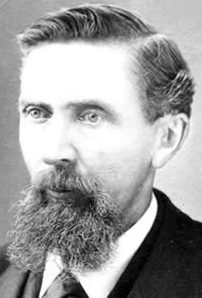 When Conrad Kohrs, immigrated to the United States at the age of 15, he was seeking his fortune like so many other immigrants were. The year was 1850, and while it is odd these days to think of a 15 year old boy immigrating to America alone now, it wasn’t entirely unheard of then. Kohrs was a native of Denmark, and had planned to head west to make his fortune in gold or silver. Unfortunately, while he had some small success in California and British Columbia, try as he might, the “big strike” always eluded Kohrs.
When Conrad Kohrs, immigrated to the United States at the age of 15, he was seeking his fortune like so many other immigrants were. The year was 1850, and while it is odd these days to think of a 15 year old boy immigrating to America alone now, it wasn’t entirely unheard of then. Kohrs was a native of Denmark, and had planned to head west to make his fortune in gold or silver. Unfortunately, while he had some small success in California and British Columbia, try as he might, the “big strike” always eluded Kohrs.
Kohrs tended to follow the crowd, and in 1862, he joined the latest western gold rush and headed for western Montana, where rich gold deposits had been found at Grasshopper Creek. It might be true that gold was plentiful at Grasshopper Creek, but Kohrs realized that he could make more money mining the miners than mining for gold. Miners need lots of supplies, and the man who was able to supply the needs, was the one who made money. He established a butcher shop in the mining town of Bannack and began to prosper.
His work as a butcher led Kohrs into the cattle business. Cattle were a big commodity, being in relatively short supply in frontier Montana. Much has changed today, and Kohrs had a big part in that. Kohrs traveled around the territory to purchase prime animals. He had several brushes with the highwaymen who plagued the isolated roads of Montana. Determined to stop these murderous bandits, Kohrs joined a group of Virginia City vigilantes, and helped track down and hang the outlaws. By 1864, robberies in the territory had plummeted. Proper or not, vigilante justice, got the point across very well.
Whether he was good at being part of a vigilante group or not, it couldn’t be what made his living. Kohrs began shifting the focus of his meat processing business to the supply side. In 1864, he established a large ranch near the town of Deer Lodge, where he fattened his cattle for market. Kohrs was pretty much the only major rancher in the western region of the territory. This caused his business to boom as Montana grew. As always happens, eventually, competition from cattle driven overland into the territory from Texas began to challenge Kohrs’ monopoly. Nevertheless, he continued to prosper, and remained the largest cattle rancher in Montana for several decades. 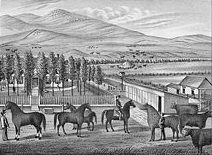
Kohrs entered the political arena in 1885, translating his economic strength into political power. He was elected to the Montana Territorial Legislature. Kohrs and his fellow ranchers had considerable influence over Montana in the years to come, and Kohrs went on to become a state senator in 1902. The big ranchers never had a free hand in Montana, however, because mining interests and farmers always kept the ranchers in check, but it wasn’t for a lack of trying. Kohrs was widely celebrated as one of the greatest pioneers in Montana history. He died on July 23, 1920 at the age of 85 in Helena.
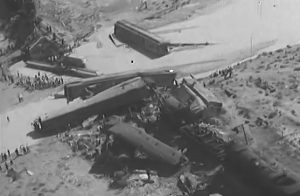 A sudden downpour near Terry, Montana on the evening of June 19, 1938 caused a flash flooding of the Custer Creek that would lead to a disaster before the night was over. Earlier in the day, a track walker was sent out the check the rail lines near Custer Creek which was located near the town of Terry, Montana. After his inspection, he reported to his superiors that the conditions were dry, and there were no problems with the tracks.
A sudden downpour near Terry, Montana on the evening of June 19, 1938 caused a flash flooding of the Custer Creek that would lead to a disaster before the night was over. Earlier in the day, a track walker was sent out the check the rail lines near Custer Creek which was located near the town of Terry, Montana. After his inspection, he reported to his superiors that the conditions were dry, and there were no problems with the tracks.
That was true at the time, but within a few hours, a sudden downpour overwhelmed Custer Creek. A small winding river, Custer Creek runs through 25 miles of the Great Plains before depositing into the Yellowstone River. Small streams like Custer Creek are prone to flash floods, because they don’t have  the capacity to handle any big influx of water, and their banks can quickly and easily be overtaken during heavy rains. As the water came rushing down stream, it washed out a bridge used by the trains. When the Olympian Special came through, it went crashing into the raging waters with no warning. Two sleeper cars were buried in the muddy waters. The night was pitch black seriously hampering rescue efforts. In all, 46 people lost their lives, and 60 others were seriously injured. The rear cars stayed above the water, but scores of passengers were seriously injured. They could not be evacuated until the following morning. I can’t even begin to imagine how awful that was.
the capacity to handle any big influx of water, and their banks can quickly and easily be overtaken during heavy rains. As the water came rushing down stream, it washed out a bridge used by the trains. When the Olympian Special came through, it went crashing into the raging waters with no warning. Two sleeper cars were buried in the muddy waters. The night was pitch black seriously hampering rescue efforts. In all, 46 people lost their lives, and 60 others were seriously injured. The rear cars stayed above the water, but scores of passengers were seriously injured. They could not be evacuated until the following morning. I can’t even begin to imagine how awful that was.
That was a tough week for Montana. Just a few days later, Black Eagle saw “torrents of water” that floated 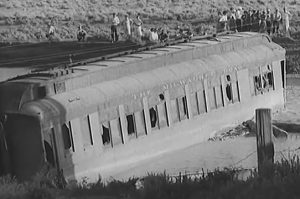 furniture in the house of Sam Tadich, the sheriff had to help a rescue effort, the road to Giant Springs washed away and water was up to cows’ flanks around the Sun River. Havre’s worst flood came in June 22, 1938, when a cloudburst in the Bear Paw Mountains sent out a wall of water. Ten people were killed. Floating train cars were wedged under the viaduct, 10 miles of highway were underwater between Laredo and Box Elder, with a bridge washed out, the Havre Daily News reported. Rain is a good thing, but too much rain, coming too fast can devastate an area, especially one with a creek or river, in a very short time, and for Montana, it was a very rainy week, making it a very tough week.
furniture in the house of Sam Tadich, the sheriff had to help a rescue effort, the road to Giant Springs washed away and water was up to cows’ flanks around the Sun River. Havre’s worst flood came in June 22, 1938, when a cloudburst in the Bear Paw Mountains sent out a wall of water. Ten people were killed. Floating train cars were wedged under the viaduct, 10 miles of highway were underwater between Laredo and Box Elder, with a bridge washed out, the Havre Daily News reported. Rain is a good thing, but too much rain, coming too fast can devastate an area, especially one with a creek or river, in a very short time, and for Montana, it was a very rainy week, making it a very tough week.
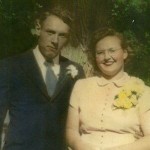 As children, the played together and even napped together, but in high school, my mother-in-law, Joann Knox Schulenberg wasn’t so sure that she liked her childhood friend very much. I don’t know if it was his teasing, or what, but I do know that my father-in-law, Walt Schulenberg was a pretty good teaser. Of course, it was always in good clean fun, and before long, she rediscovered the reasons she liked him when they were young. Before long, they knew that their love was the forever kind of love, and so they married and began their life together. Their life would take them away from their hometown of Forsyth, Montana, and eventually land them and their young family in Casper, Wyoming, which would be their home for the remainder of their lives, with the exception of the snowbird years, when they wintered in Yuma, Arizona.
As children, the played together and even napped together, but in high school, my mother-in-law, Joann Knox Schulenberg wasn’t so sure that she liked her childhood friend very much. I don’t know if it was his teasing, or what, but I do know that my father-in-law, Walt Schulenberg was a pretty good teaser. Of course, it was always in good clean fun, and before long, she rediscovered the reasons she liked him when they were young. Before long, they knew that their love was the forever kind of love, and so they married and began their life together. Their life would take them away from their hometown of Forsyth, Montana, and eventually land them and their young family in Casper, Wyoming, which would be their home for the remainder of their lives, with the exception of the snowbird years, when they wintered in Yuma, Arizona.
Over the years their family would grow as six children joined, one at a time. Four daughters and two sons 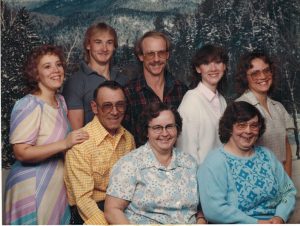 blessed their lives. The girls learned all the homemaking skills that their mother had to offer, from sewing to crocheting, to cooking and canning, ad of course, cleaning and doing laundry. Their mother poured all of her housekeeping knowledge into her daughters, so they would have the necessary skills to make homes of their own. For his part, their dad took his sons under his wing and taught them mechanics, so that they could keep their vehicles in good running condition. He taught them how to build things…everything from a simple shelf to an entire home. He gave them the skills they would need to make a living and take care of the needs of their families. As the years went by, their six children blessed them with ten grandchildren, 13 great grandchildren, and since their passing a new great
blessed their lives. The girls learned all the homemaking skills that their mother had to offer, from sewing to crocheting, to cooking and canning, ad of course, cleaning and doing laundry. Their mother poured all of her housekeeping knowledge into her daughters, so they would have the necessary skills to make homes of their own. For his part, their dad took his sons under his wing and taught them mechanics, so that they could keep their vehicles in good running condition. He taught them how to build things…everything from a simple shelf to an entire home. He gave them the skills they would need to make a living and take care of the needs of their families. As the years went by, their six children blessed them with ten grandchildren, 13 great grandchildren, and since their passing a new great  great granddaughter. The family has spent many years enjoying many wonderful family moments and many holidays. Some of their greatest joys were bring grandparents and great grandparents.
great granddaughter. The family has spent many years enjoying many wonderful family moments and many holidays. Some of their greatest joys were bring grandparents and great grandparents.
Joann and Walt were married on June 6, 1949 in Forsyth, Montana, and had been married almost 64 years when Walt went home to Heaven n May 5, 2013. Joann followed him this year on January 4, 2018, and so this is their first anniversary in Heaven. While we miss them very much, we are happy that they are together again. Happy anniversary Mom and Dad. It would have been 69 years today, since you said, “I do.” We love and miss you very much.
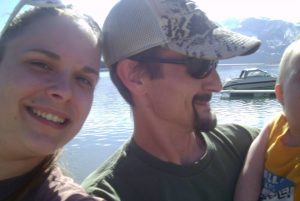 My niece, Cassie Iverson is a patient, loving mother of two beautiful children 6 year old Lucas, and 2 year old Zoey. She loves to go camping with the family, and they go as often as they can, because Cassie is a photographer, and is drawn to the beautiful side of life. Much of her photography is of nature, which appeals to me very much, as a nature lover too. Good photography requires an eye for staging. It’s strange to thing of staging the shot for nature, but things like what is centered, how much to zoom, and good lighting are vital to taking a great picture. Cassie has that eye for staging, and so her pictures come of beautiful and they draw you into the scene.
My niece, Cassie Iverson is a patient, loving mother of two beautiful children 6 year old Lucas, and 2 year old Zoey. She loves to go camping with the family, and they go as often as they can, because Cassie is a photographer, and is drawn to the beautiful side of life. Much of her photography is of nature, which appeals to me very much, as a nature lover too. Good photography requires an eye for staging. It’s strange to thing of staging the shot for nature, but things like what is centered, how much to zoom, and good lighting are vital to taking a great picture. Cassie has that eye for staging, and so her pictures come of beautiful and they draw you into the scene.
She takes pictures of her children and of other people too, and she has a great 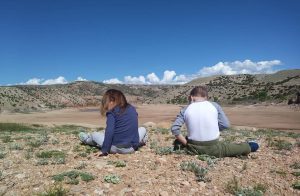 eye for staging those photos too, but her real love for photography lies in photographing nature. It makes perfect sense, since she loves to be camping more than living in town. She and her husband, Chris like to fish and camp out with the kids…showing them all the beauty that nature has to offer. While she loves photography, Cassie’s kids really are her whole heart.
eye for staging those photos too, but her real love for photography lies in photographing nature. It makes perfect sense, since she loves to be camping more than living in town. She and her husband, Chris like to fish and camp out with the kids…showing them all the beauty that nature has to offer. While she loves photography, Cassie’s kids really are her whole heart.
Her son, Lucas has had some medical issues over the past few years and so now the family is looking to move to a bigger city where the necessary medical facilities are available. They have looked in Montana, Colorado, and Tennessee. At this point, it looks like Tennessee might be the best place for them, so they are hoping to move sometime this summer. I know that many people in the family would rather have them in Montana or 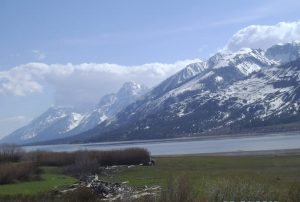 Colorado, but that may not be feasible. Time will tell I guess, and we will have to see where they land. Of course, if they move to Tennessee, we will all miss them, but thankfully Facebook can keep us in the loop with their lives. The most important thing for the family is to be near enough to good medical care for Lucas, so they don’t have to travel every time he needs surgery or other treatments. One thing that is for sure, this move, no matter where it takes them, will open up a whole new world of photography vistas for Cassie. I can’t wait to see the pictures she will take now. Today is Cassie’s birthday. Happy birthday Cassie!! Have a great day!! We love you!!
Colorado, but that may not be feasible. Time will tell I guess, and we will have to see where they land. Of course, if they move to Tennessee, we will all miss them, but thankfully Facebook can keep us in the loop with their lives. The most important thing for the family is to be near enough to good medical care for Lucas, so they don’t have to travel every time he needs surgery or other treatments. One thing that is for sure, this move, no matter where it takes them, will open up a whole new world of photography vistas for Cassie. I can’t wait to see the pictures she will take now. Today is Cassie’s birthday. Happy birthday Cassie!! Have a great day!! We love you!!
 When a crime is committed, it seems to take forever to bring justice for the victims. Sometimes people just don’t want to wait, or they are so mad about the crime committed against them or their family, that they decide, either consciously or unconsciously, to take matters into their own hands. This is known as vigilante justice, and while we still have it today, it really was more prevalent in the Old West….at least as it applies to storming the jail and hanging the “criminal” accused of the crime, without a trial.
When a crime is committed, it seems to take forever to bring justice for the victims. Sometimes people just don’t want to wait, or they are so mad about the crime committed against them or their family, that they decide, either consciously or unconsciously, to take matters into their own hands. This is known as vigilante justice, and while we still have it today, it really was more prevalent in the Old West….at least as it applies to storming the jail and hanging the “criminal” accused of the crime, without a trial.
Vigilante justice was more common in the wild west days because law enforcement was almost non-existent. Vigilantes took it upon themselves to “enforce the law,” as well as their own moral code, even if the event was not necessarily against the law. When a mob would decide that a prisoner is guilty, they would storm the jailhouse, drag the prisoner out, down the street to a big tree, and there they would hang the prisoner, whether they were guilty or not. The mob had decided. I suppose that a lot of times the person who was hanged was guilty of the crime, but without a trial and evidence to prove their guilt, how could anyone be sure?
The term vigilante stems from the its Spanish equivalent, meaning private security agents, but the vigilantes of 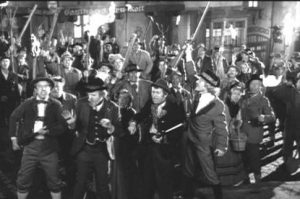 the old west and the mobs, who riot for their idea of right these days, have little in common with security agents. Most vigilantes and mobs are driven anger and adrenaline. Unfortunately those two things together don’t often bring a good outcome, and in the case of lynch mobs, it’s never a good outcome. Old West vigilantes were most common in mining communities, but were also known to exist in cow towns and in farming settlements. These groups usually formed before law and order existed in a new settlement. The justice dished out included whipping and banishment from the town, but more often, offenders were lynched. And sometimes the vigilante groups formed in places where lawmen did exist, but were thought to be weak, intimidated, or corrupt.
the old west and the mobs, who riot for their idea of right these days, have little in common with security agents. Most vigilantes and mobs are driven anger and adrenaline. Unfortunately those two things together don’t often bring a good outcome, and in the case of lynch mobs, it’s never a good outcome. Old West vigilantes were most common in mining communities, but were also known to exist in cow towns and in farming settlements. These groups usually formed before law and order existed in a new settlement. The justice dished out included whipping and banishment from the town, but more often, offenders were lynched. And sometimes the vigilante groups formed in places where lawmen did exist, but were thought to be weak, intimidated, or corrupt.
Some people see vigilantes as heroes, thereby giving them he support of some of the law-abiding citizens. Some people saw them as a necessary step to fill a much needed gap. Nevertheless, sometimes the vigilance committee began to wield too much power and became corrupt themselves. At other times, vigilantes were nothing more than ruthless mobs, attempting to take control away from authorities or masking themselves as “do-gooders” when their intents were little more than ruthless or they had criminal intent on their own minds. One of the first vigilante groups formed was the San Francisco Vigilantes of 1851. After several criminals were hanged the committee was disbanded. When the city administration, itself, became corrupt, a vigilante group formed once again in 1856. There were many vigilante groups formed in the American West. The Montana 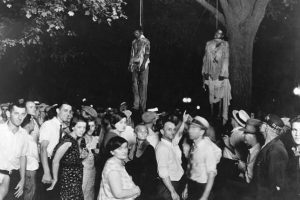 Vigilantes who hanged Bannack Sheriff Henry Plummer in 1864. They controlled the press, so the sheriff was made out to be the leader of an outlaw gang called the Innocents. Further investigation indicates that it might have been the vigilante group, themselves, who were behind the chaos reigning in Montana and that Henry Plummer was an innocent man. Following the Civil War, the Reno Gang began to terrorize the Midwest, resulting in the formation of the Southern Indiana Vigilance Committee. The next time the Reno Gang attempted to rob a train, a the vigilante group lynched its leaders…Frank, William and Simeon Reno. Vigilantes did good in some instances, but it was not really the best form of justice.
Vigilantes who hanged Bannack Sheriff Henry Plummer in 1864. They controlled the press, so the sheriff was made out to be the leader of an outlaw gang called the Innocents. Further investigation indicates that it might have been the vigilante group, themselves, who were behind the chaos reigning in Montana and that Henry Plummer was an innocent man. Following the Civil War, the Reno Gang began to terrorize the Midwest, resulting in the formation of the Southern Indiana Vigilance Committee. The next time the Reno Gang attempted to rob a train, a the vigilante group lynched its leaders…Frank, William and Simeon Reno. Vigilantes did good in some instances, but it was not really the best form of justice.
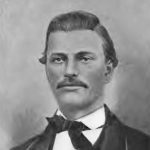 The move west to settle America was seldom a peaceful move. These days we think of loading up our car, and moving to a new city…done and easy, but it wasn’t so back then. There were outlaws, Indians, and unknown perils that could end a trip west, almost before it got started. There were a number of trails commonly used to get to the gold fields in the west, but the Bozeman Trail was one of the most violent, quarrelsome, and ultimately failed experiments in American frontier history. The trail was named for John Bozeman, an emigrant from Georgia, who was said to have blazed the route, but in actuality, the Indians had been using the route as a travel corridor for centuries. Nevertheless, John Bozeman did play a part in the trail. In 1863, Bozeman and partner, John Jacobs widened this corridor for use as a wagon road. They were following in much the same footsteps as Captain William Raynolds had four years earlier in a mapping and exploration expedition for the Army Corps of Topographic Engineers. The plan was to make the trail a shortcut to the goldfields in and around Virginia City, Montana territory. The Bozeman route split off of the Oregon Trail in central Wyoming. Then it skirted the Bighorn Mountains, crossed several rivers including the Bighorn, then traversed mountainous terrain into western Montana. The trail follows a very similar route to the current roads that meander through Wyoming today. The Bozeman trail had several advantages, including an abundant supply of water along with the most direct route to the goldfields, making it the go to trail of that era.
The move west to settle America was seldom a peaceful move. These days we think of loading up our car, and moving to a new city…done and easy, but it wasn’t so back then. There were outlaws, Indians, and unknown perils that could end a trip west, almost before it got started. There were a number of trails commonly used to get to the gold fields in the west, but the Bozeman Trail was one of the most violent, quarrelsome, and ultimately failed experiments in American frontier history. The trail was named for John Bozeman, an emigrant from Georgia, who was said to have blazed the route, but in actuality, the Indians had been using the route as a travel corridor for centuries. Nevertheless, John Bozeman did play a part in the trail. In 1863, Bozeman and partner, John Jacobs widened this corridor for use as a wagon road. They were following in much the same footsteps as Captain William Raynolds had four years earlier in a mapping and exploration expedition for the Army Corps of Topographic Engineers. The plan was to make the trail a shortcut to the goldfields in and around Virginia City, Montana territory. The Bozeman route split off of the Oregon Trail in central Wyoming. Then it skirted the Bighorn Mountains, crossed several rivers including the Bighorn, then traversed mountainous terrain into western Montana. The trail follows a very similar route to the current roads that meander through Wyoming today. The Bozeman trail had several advantages, including an abundant supply of water along with the most direct route to the goldfields, making it the go to trail of that era.
Still, the trail had one major drawback. It cut through the heart of territory that had been promised to several Indian tribes by the Treaty of Fort Laramie in 1848, making the people traveling the trail…the outlaws. The area included the rich hunting grounds of the Powder River Country, claimed by the Sioux and other tribes. They were not feeling very hospitable about these “white men” traipsing through their hunting grounds, killing their animals, and running off many in the herds. Nevertheless, the first emigrant trains began traveling up the trail not long after Bozeman and Jacobs had finished marking the route. In 1864, a large train of 2,000 settlers 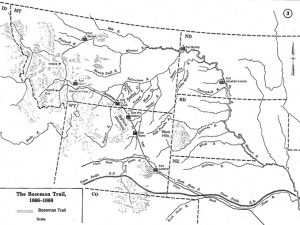 successfully made the trek. This was the high point of travel along the corridor. Though some wagon trains were successful after that, there were constant threats of attack. Over the next two years travel along the corridor came to a complete halt because of numerous raids by a coalition of tribes.
successfully made the trek. This was the high point of travel along the corridor. Though some wagon trains were successful after that, there were constant threats of attack. Over the next two years travel along the corridor came to a complete halt because of numerous raids by a coalition of tribes.
Then the people started to put pressure on the United States government to protect the travelers. In 1866, United States Army troops were dispatched to construct three forts along the trail, which would supposedly offer protection to wagon trains. These posts, running from south to north, were Forts Reno, Phil Kearny and C.F. Smith. Ominously, each of these forts was named after a general that had died during the just completed Civil War. Somehow that doesn’t seem to instill a lot of hope…at least to me. With the installation of the forts, the trail had, in effect become a military road. The protection afforded by the United States Army presence enraged the tribes. With that intervention came a two year conflict, known as Red Cloud’s War. Under the leadership of Oglala Lakota chief Red Cloud, raids and ambushes were carried out against soldiers, civilians, supply trains and anyone else who dared to attempt the trail.
Three famous skirmishes were The Fetterman Massacre, in December, 1866, in which an army detachment of 79 soldiers and 2 civilians led by Captain William Fetterman were lured from Fort Phil Kearney and ambushed within a few miles of the fort. On August 1, 1867, the Hayfield Fight, where 19 soldiers and 6 civilians detailed for guard and hay cutting duty were attacked. The Indians held them under siege for over 8 hours, but they managed to hold off 500 hundred warriors until help arrived. And finally, The Wagon Box Fight, where a detachment of 31 soldiers sent out to guard a team of wood cutters, was encircled. They fought off numerous attacks over a five hour period from hundreds of warriors. These continued raids and skirmishes were the rule that proved that peace was not going to be the reality they had hoped. Life guarding the trail was a 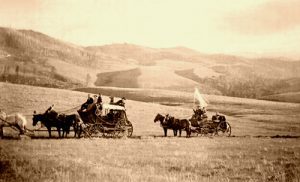 combination of tension, monotony, and loneliness. Soldiers on the verge of mutiny and even cases of insanity, deserted their posts. With few, if any, emigrants using the trail, because they were too afraid, the army sequestered behind fortress walls and tribes showing few signs of easing up on attacks. Finally, the United States government decided to pursue a peace policy. The second (1868) Fort Laramie Treaty recognized the Powder River Country once again as the hunting territory of the Lakota and their allies. A presidential proclamation was issued to abandon the forts. The Bozeman Trail was history, and for the first time, the United States government had lost a war. What a shock that must have been for our nation.
combination of tension, monotony, and loneliness. Soldiers on the verge of mutiny and even cases of insanity, deserted their posts. With few, if any, emigrants using the trail, because they were too afraid, the army sequestered behind fortress walls and tribes showing few signs of easing up on attacks. Finally, the United States government decided to pursue a peace policy. The second (1868) Fort Laramie Treaty recognized the Powder River Country once again as the hunting territory of the Lakota and their allies. A presidential proclamation was issued to abandon the forts. The Bozeman Trail was history, and for the first time, the United States government had lost a war. What a shock that must have been for our nation.
 My grandniece, Siara Harman is a tiny little girl, just 4 feet 9 inches tall, but don’t let that fool you, because she is one tough cookie. She works out, and she’s really strong. After high school, Siara spent a year in Great Falls, Montana going to school, and representing the college as a cheerleader. During that year, she worked out and cheered at a pace most of us would find exhausting. Nevertheless, Siara took it all on stride. After that year, Siara returned home, mostly because she missed her family, I think…especially her mom, but also to continue her studies in her home town.
My grandniece, Siara Harman is a tiny little girl, just 4 feet 9 inches tall, but don’t let that fool you, because she is one tough cookie. She works out, and she’s really strong. After high school, Siara spent a year in Great Falls, Montana going to school, and representing the college as a cheerleader. During that year, she worked out and cheered at a pace most of us would find exhausting. Nevertheless, Siara took it all on stride. After that year, Siara returned home, mostly because she missed her family, I think…especially her mom, but also to continue her studies in her home town.
Siara is the type of person who takes time to decide to commit to most things, but once she does, she is all in. After her mom, my niece, Chantel Balcerzak remarried, it took Siara 18 months before she started calling her step-dad, Dave Balcerzak, “Dad.”  Her brother, Jake Harman was much quicker to accept his step-dad. Nevertheless, once Siara committed to calling Dave “Dad,” she was in, wholeheartedly, and as far as she is concerned, Dave is her dad. Commitment, while not forthcoming, is something Siara takes very seriously.
Her brother, Jake Harman was much quicker to accept his step-dad. Nevertheless, once Siara committed to calling Dave “Dad,” she was in, wholeheartedly, and as far as she is concerned, Dave is her dad. Commitment, while not forthcoming, is something Siara takes very seriously.
Over the years, Siara has had a number of boyfriends, but once again she was very slow to commit to any of them. Siara was in two serious relationships before her current relationship, but once the conversation turned to marriage, her mom could always tell that it was, “Nope, not yet.” Her heart couldn’t move in that direction yet. With her fiancé, Nick Olsen, things would be different. While she and Nick have been dating for a while now, it took Siara only two week to tell her mom that, “No matter when he asks, the answer is yes.” I guess that when it’s the right one, commitment is easy. Siara and Nick will be married this summer.

As I said, Siara is a tiny, short little girl, and I recall that a few years ago…before she was “fully” grown, she told me that she wanted to be 5 feet 7 inches tall…an impossibility for our little Siara, who is full grown at 4 feet 9 inches. Knowing that she would never achieve that lofty goal, I told her to wear high heels, because that was going to be the only way she would ever be taller. She took my advise, and these days, with heels she is over 5 feet, anyway. Siara has decided that she is not going to take that chance with there kids, so she is going to marry a tall man. Of course, it wasn’t his height that won Siara’s love, but rather his heart. Still, Nick’s height was not a negative to Sara, even if he practically has to pick her up to kiss her. The really good news is that since Siara loves a very tall man, her kids might have a chance to be taller than she is. I guess that’s some consolation to Siara’s height dilemma. Today is Siara’s birthday. Happy birthday Siara!! Have a great day!! We love you!!
 My husband’s uncle, Eddie Hein has always been a soft-spoken man, who had a big impact on the lives of those around him. I remember the first time I met Eddie. I liked him and his wife, Pearl very much. They were kind and welcoming, and to this day, we love to go to visit them in Forsyth, Montana, although we don’t get to go nearly as often as we used to. Before his retirement, Eddie worked long, hard hours at the Peabody coal mine in Colstrip, Montana. It was shift work, and it was hard on the body, but Eddie made a good living and supported his family well. The long hours always seemed twice as long as they were…especially at the end of a long week of them.
My husband’s uncle, Eddie Hein has always been a soft-spoken man, who had a big impact on the lives of those around him. I remember the first time I met Eddie. I liked him and his wife, Pearl very much. They were kind and welcoming, and to this day, we love to go to visit them in Forsyth, Montana, although we don’t get to go nearly as often as we used to. Before his retirement, Eddie worked long, hard hours at the Peabody coal mine in Colstrip, Montana. It was shift work, and it was hard on the body, but Eddie made a good living and supported his family well. The long hours always seemed twice as long as they were…especially at the end of a long week of them.
Coal mining was Eddie’s occupation, but it was not his life…not his heart. His heart belonged to his family. Eddie remodeled their home largely by himself, and did a beautiful job. Eddie worked hard, alongside Pearl, of course, weeding their garden, and growing their vegetables, and then canning the vegetables for use all year long. It was a project they did together, especially after Pearl went to work too. Eddie and Pearl were always there to help their friends and neighbors too. People only had to call, and they would do whatever was needed. I suppose that is just the way it is in a small town, but more likely it is just they way they are. Eddie and Pearl are very helpful people, just ask anyone.
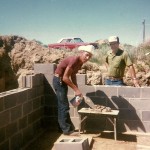
Eddie has always loved tractors. He was always working on one or two, and there were always tractors in their back yard. He used them to help friends with their haying, or digging something for someone when needed. I’m sure he used them in their own garden too, because you can’t really have a successful garden if you don’t plow it and such. My husband, Bob remembers those tractors well, but then I guess he would. It’s kind of a guy thing, and being a mechanic, just like his Uncle Eddie, working on tractors would have a draw for him too. I’m sure those tractors gave them lots to talk about, and I know that they both enjoyed those visits very much. Today is Eddie’s 74th birthday. Happy birthday Eddie!! Have a great day!! We love you!!
 The discovery of gold in the United States triggered massive growth, with towns springing up across the area. Helena, Montana was one of those towns. On October 30, 1864, four miners struck it rich at their appropriately named mine, “Last Chance Gulch.” From that discovery came one of the wealthiest cities in the United States by the late nineteenth century…Helena, Montana. While it was once one of the wealthiest cities, the current population of Helena doesn’t really fall in line with the direction the city appeared to be taking in 1864. As of the 2010 census the population is 28,190, making it the fifth least populous state capital in the U.S after Montpelier, Vermont; Pierre, South Dakota; Augusta, Maine; and Frankfort, Kentucky.
The discovery of gold in the United States triggered massive growth, with towns springing up across the area. Helena, Montana was one of those towns. On October 30, 1864, four miners struck it rich at their appropriately named mine, “Last Chance Gulch.” From that discovery came one of the wealthiest cities in the United States by the late nineteenth century…Helena, Montana. While it was once one of the wealthiest cities, the current population of Helena doesn’t really fall in line with the direction the city appeared to be taking in 1864. As of the 2010 census the population is 28,190, making it the fifth least populous state capital in the U.S after Montpelier, Vermont; Pierre, South Dakota; Augusta, Maine; and Frankfort, Kentucky.
My husband, Bob Schulenberg’s aunt, Marion Kanta, and her family lived in Helena until the time for her passing in 1999, and many of her family members live there still. That said, we visited the capitol city a few times, and found it to be a very nice place. Of course, during the gold rush years, things might have been very 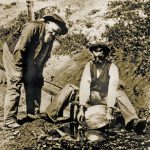 different. A gold rush town can have a tendency to be a high crime area, and when 3.6 billion dollars worth of gold is extracted in the city limits of a town over a twenty year period, you know that there were people who would like nothing more than to take over the claim of another person, no matter what it took. The first major Anglo settlement of Montana began in the summer of 1862, when prospectors found a sizeable deposit of placer gold at Grasshopper Creek to the west of what is today…Helena, Montana. When other even richer deposits were discovered nearby, a major rush began as tens of thousands of miners scoured the territory in search of gold. In 1864, four prospectors spotted signs of gold in the Helena area while on their way to the Kootenai country, but they were eager to reach the reportedly rich gold regions farther to the north and did not stop. Then, after striking out on the Kootenai, they decided to take “one last chance” on finding gold and returned. When the signs turned out to mark a rich deposit of placer gold, they staked their claims and named the new mining district Last Chance Gulch.
different. A gold rush town can have a tendency to be a high crime area, and when 3.6 billion dollars worth of gold is extracted in the city limits of a town over a twenty year period, you know that there were people who would like nothing more than to take over the claim of another person, no matter what it took. The first major Anglo settlement of Montana began in the summer of 1862, when prospectors found a sizeable deposit of placer gold at Grasshopper Creek to the west of what is today…Helena, Montana. When other even richer deposits were discovered nearby, a major rush began as tens of thousands of miners scoured the territory in search of gold. In 1864, four prospectors spotted signs of gold in the Helena area while on their way to the Kootenai country, but they were eager to reach the reportedly rich gold regions farther to the north and did not stop. Then, after striking out on the Kootenai, they decided to take “one last chance” on finding gold and returned. When the signs turned out to mark a rich deposit of placer gold, they staked their claims and named the new mining district Last Chance Gulch.
Last Chance Gulch would prove to be the second biggest placer gold deposit in Montana, producing some 19 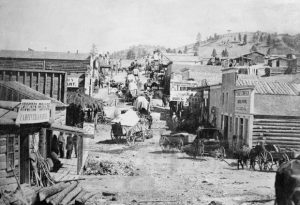 million dollars worth of gold in just four years. Almost overnight, thousands of miners flooded into the region, and the four original miners added to their fortunes by establishing the town of Helena to provide the new miners with food, lodging, and supplies. But unlike many of the early Montana mining towns, Helena did not disappear once the gold gave out, which was inevitable. Helena was able to survive and grow by serving the wider Montana mining industry, because it was located on several major transportation routes, well supplied with agricultural products from an adjacent valley, and near to several other important mining towns. In 1875, the city became the capital of Montana Territory, and in 1894, the capital of the new state of Montana.
million dollars worth of gold in just four years. Almost overnight, thousands of miners flooded into the region, and the four original miners added to their fortunes by establishing the town of Helena to provide the new miners with food, lodging, and supplies. But unlike many of the early Montana mining towns, Helena did not disappear once the gold gave out, which was inevitable. Helena was able to survive and grow by serving the wider Montana mining industry, because it was located on several major transportation routes, well supplied with agricultural products from an adjacent valley, and near to several other important mining towns. In 1875, the city became the capital of Montana Territory, and in 1894, the capital of the new state of Montana.

